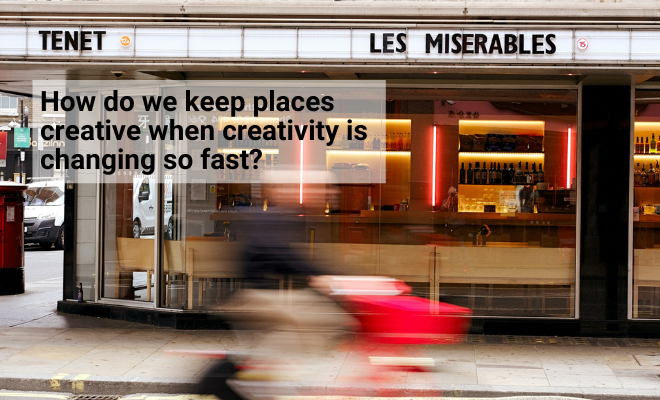Place and creativity have always been deeply entangled. But in a world being changed by new technologies, how do we keep places creative, when the nature of creativity is changing so much and so fast?
By Chris Michaels, Strategy Consultant and Advisor to cultural, creative and research organisations.
This week I launched a report I’ve written for the Heart of London Business Alliance (“HOLBA”), the business improvement district for London’s West End in Westminster.
“A Home for Tomorrow’s Creative Innovation” looks at both a challenge and an opportunity facing one of the world’s most famously creative places – the few small blocks around Leicester Square, Charing Cross Road, and Piccadilly Circus that house some of the world’s greatest museums, galleries, theatres, opera houses and more, and that have historically been home to critical parts of the Creative Industries.
The report builds on an earlier initiative I was involved in whilst an Executive Director at the National Gallery – HOLBA’s redefinition of an area of the West End as an Arts Quarter, and the strategic process of change that would need to follow to bring new forms of business, entrepreneurialism and investment into that area.
When I looked at how London’s innovation landscape was changing whilst researching the report, I could see a major risk of an ongoing process of hollowing out, accelerating and leaving a centre of global importance behind.
We know the Creative Industries are in a period of growth, with over 20% of London’s workforce, over 1.1m people working in this sector, up by nearly 300,000 jobs in just three years, and with a potential 1.2m new jobs to come in the next decade.
But in Westminster, for decades the borough with the largest share of London’s Creative Industries, the Creative Industries are in an under-recognised period of decline, with nearly a 20% reduction of its share of the total volume of creative sector over the last decade.
That’s happening because of investment and because of the changing nature of what creative businesses do.
Multi-billion pound investment in dedicated locations for innovative new businesses are happening elsewhere – in Stratford, the Thames Estuary, Hayes and Harlington, and more. Connected by high-speed infrastructure like the Elizabeth Line, these ventures are delivering not just rich socio-economic benefits, but also benefits to property and land-owner value, and those who invest in them.
Where Creative Industries businesses are situated is changing – and so is what they do.
The birth-rate of new companies shows how many businesses of what type are created per year. Between 2015 and 2020, the largest decline was in the IT and Software sectors, with the number of new businesses in London down from 25.2% in 2015 to 11.4% in 2020. This accounted for more than three-quarters of the overall decline in new business registrations in London’s creative industries.
In simple terms, today’s creative sector businesses are moving to London’s margins or out of London altogether to places that better fit their needs.
But what about tomorrow’s? Is there a new category of creativity which the benefits of London’s dense middle can bring?
I believe so – and it comes in the form of the CreaTech sector which is emerging at speed.
The success of “CreaTech” is a new kind of UK success story. Whilst early research by the Creative Industries Policy and Evidence Centre found 2,000 of these businesses in 2022, current research I’m involved in as part of the Royal Anniversary Trust suggests that number might now reach 14,000. This is an exploding category.
And a category that along with HOLBA, Westminster Council and more, I want to help bring to the backstreets of the very epicentre of London.
We’ve identified the possibility for 100 CreaTech businesses to come to the Arts Quarter – from new start-ups, to maturing companies, and to help shape its future. Partnerships with the world’s greatest arts institutions, showcasing on the world’s most popular city streets, access to world- leading research institutions and business support. These are all part of our vision.
Now we want to make it real, and make the middle of the greatest city in the world a space for Creative Technology.
Wish us luck, and please, help us on our journey.
– – –
Biography:
Chris Michaels is a strategy consultant and advisor to cultural, creative and research organisations. He is the Deputy Chair of English Heritage and sits on the digital advisory boards of the BFI and the National Gallery. He writes the weekly Substack, “Creative R&D: Art / Ideas / Technology”
Photo by Kevin Grieve on Unsplash


